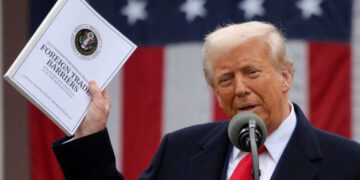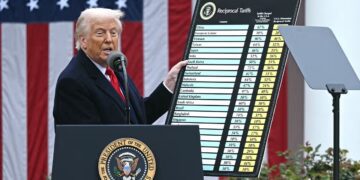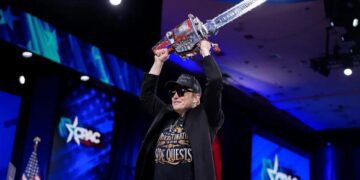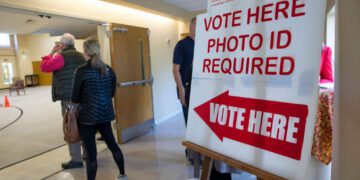By John F. Di Leo -
Reflections on the anniversary of the first meeting of the Electoral College
On February 4, 1789, 69 specially-chosen politicians from ten states met for the one and only purpose of their existence: acting as the first Electoral College, and voting for our nation’s first President under its new “Constitutional” government.
The event was full of “firsts.” In the 18th century, heads of state were almost always hereditary monarchs. The few true republics throughout history – such as ancient Rome and relatively small contemporary city-states – had generally tried to make do without any executive at all, for fear that they would make a quick move from republic to dictatorship, as soon as a strong leader had a taste of power.
But our Constitution’s Framers had already attempted life on a large scale without a single head of state, and they found that it just didn’t work. Under the Articles of Confederation, not only was the government generally weak, the individual known as the “President of Congress” was also weak… if anything, those first Presidents were the embodiment of the weakness of the Confederation Congress. They were just presiding officers of a dysfunctional board, not heads of state as we understand the term today. This was certainly not the fault of the men who held the post; Hancock, Jay, Lee, Boudinot and the rest (there had been fourteen, in all) were all accomplished and competent patriots… but the old system had tied their hands, so that whatever leadership potential they possessed remained unused.
The Framers had learned their lesson. We needed a head of state – an Executive – independent of Congress and the Judiciary – who could serve as the people’s protector against the political class, and against the powerful interests that were sure to arise as the years went by. But designing this office, and figuring out how best to choose its occupant, had proven to be the wildest ride of the entire Constitutional Convention.
Virtually all of the delegates to the Convention were experienced legislators, people who had served in their state houses and/or in the national congress. Two of the delegates, Nathaniel Gorham and Thomas Mifflin, had even served as president themselves.
For those who spent the summer of 1787 at Philadelphia’s Independence Hall, two competing forces were on everyone’s mind: the clear need to design a government more robust than the old one, balanced by an equal need to remember that the whole purpose of our War of Independence was to secure liberty, so this new government must not fail in that purpose.
When it came to the question of the executive, this meant one key point: we could hardly demand freedom from one king, only to set up a new king of our own, less than a decade later.
Proposals for the executive were all over the map: A four-year term? A seven-year term? Eleven years? Fifteen even? Since one of the major fears would be that a president hoping for reelection would be too easily controlled by congress, perhaps ever-longer terms might be the answer. Finally, Rufus King proposed a ridiculous twenty-year term for the presidency, just to put an end to that discussion.
The manner of choosing the president was even more worrisome. As the single most important individual in the government, they knew they had to get it right. But how?
Proposals included having Congress pick the president… but our own example under the Articles argued against doing that again. Perhaps we could have the state legislatures pick him… but then he might be too tied to the region of his geographical support. At one point, James Wilson proposed appointing a committee of 15 congressmen – selected at random, by drawing lots! – to be sequestered until they agreed on a president (white smoke optional, one assumes).
Some proposed that the choice of the president should be entirely up to the people – to hold a national election, leaving the most important government position in the hands of a momentary majority’s whim. This last idea – a national popular vote for the presidency – was too terrifying to contemplate, as this group of experienced statesmen knew better than to give such a direct democratic power to “the mob.”
There were certain problems with a national popular vote for the president. In those days, different states had different rules for voting rights. Until recently, in the 20th century, anyway, voting rules were generally standardized in the United States – non-felon US citizens could all vote once, from their primary address. Simple and straightforward (though the explosion of vote fraud in recent years has removed a good deal of that standardization). In the Founding era, however, the franchise was much more unevenly distributed.
In some states, only male property-holding citizens could vote… in others, all free men could… in New Jersey, men and women of property could vote, but men and women without property were excluded. Slaves, members of the Indian nations, and foreigners could not vote, of course.
The Framers didn’t intend to micromanage these voting rules – they were fine with leaving it up to the states – but they couldn’t choose their presidential system in pretended ignorance of the facts on the ground, either. If each person’s vote was of considerably different strength from state to state, then that would be a powerful argument against a popular vote method for the presidency.
(Aside: This problem has only become greater of late. While all states have done away with voting restrictions based on color, property or sex, some retain the felon ban while others dilute the electorate by allowing felons to vote. Some allow, even encourage, non-citizens to vote, amazingly, both legal residents and illegal aliens. And many states tolerate – or even encourage – the most outrageous of the countless methods of vote fraud, further diluting the value of the vote of the ever-fewer rightful voters in the pool.)
In the end, the delegates settled on a marvelous construct, one of their most brilliant ideas: the Electoral College.
The Framers designed the two houses of Congress to provide a certain balance: the Senate was chosen by the state governments, while the House was chosen directly by the voters. If the Presidency was to respect the sovereignty of both the individual citizens and the state governments, then perhaps the presidency could be selected by a system that involved both groups.
The Electoral College would be a group of respected dignitaries, appointed by each state, in numbers taken from the total number of house and senate members of each state. If a state had one congressman, it would have three electors. If a state had nine congressmen, it would have eleven electors. How they chose the individual electors was up to the states, as was how they required them to vote. Today, 48 states deliver all their electoral votes to the winner of the popular vote in their state; the other two (Maine and Nebraska) give their two statewide electoral votes to the popular vote winner in their state, then give the other electors to the popular vote winner of each respective congressional district.
In that first election, it was up to the states to sort out the details. Some states held a regular election, others left it in the hands of their legislatures; either way, by February 4, ten states had managed to send their electors to the official meeting, so they could vote for two qualified people (at least one of whom would have to be from a state other than their own). The top vote-getter would become the president, and the runner-up would serve as vice president.
It may look odd to us, today, in retrospect, that the Framers left so much up to the states. Can it be that they didn’t realize that bitter enemies might end up serving together as President and Vice President? Might they not have anticipated the development of political parties to run unified tickets?
No, they knew such things were possible, but they hoped to postpone the rise of parties, and they hoped that two statesmen thrown together by such an election would be able to get along. There was a great deal of hope, in those days, mixed in with their careful plans and the many checks and balances that were built into the document. The elections of 1796 and 1800 were to showcase certain flaws, earlier than expected, resulting in a Constitutional amendment that took parties into consideration.
For the election of 1788, they had much less pressure than we might expect, because there was one foregone conclusion all along: if our new government was going to have a president, that president would most certainly be George Washington.
During the Founding era, two Americans loomed larger than life on the American landscape: Pennsylvanian Benjamin Franklin and George Washington.
- Franklin had been a businessman, writer, musician, scientist, and inventor, a local politician in his colony and a diplomat abroad.
- Washington had been a surveyor, horticulturalist, businessman, horseman, military leader, and politician.
These two men had the distinction of being thought of by the world as Americans, rather than as identifying them by their states, as was the norm. But Franklin was elderly; if we wanted someone young enough to be considered for the biggest job in the land, Washington stood alone.
Due to his service in the French and Indian War, and his service in advocating for the veterans of that conflict in the years that followed, Washington was among the most well-travelled politicians in the colonies. If we were to have a head of state, virtually any other would have been thought of as a Georgian, a New Yorker, a Pennsylvanian… but George Washington was claimed by all Americans as one of them; to people outside Virginia, he wasn’t a Virginian at all, he was an American. The American, one might argue. The first of the breed, in a time when a national identity was still a very new thing indeed.
Washington’s most recent service to the new nation had been coming out of retirement to chair the Constitutional Convention, and his service before that had been his successful role as Commander in Chief during the eight-year-long War of Independence.
But his service predated the 1770s and 80s. As a Virginia legislator, George Washington led Virginia and the rest of the south in joining the coastwise boycott in 1769, a non-importation agreement that had begun in New England, and taken root. And long before that, his service as the Colonial “resident expert” who served with the British army during the French and Indian War made him a national hero before there was even a nation.
George Washington was Father of his Country before there even was a country; he would be the first President, without a doubt.
No one had stood up for Americans against the Crown’s overreach longer than Washington. No one had seen more of the country and worked with more of his countrymen than Washington. When the king reneged on promises made to colonial soldiers for their service in the French and Indian War, Washington continued to lobby for them long after anyone else would have given up. And that same reason surfaced again in the 1780s, when economic depression made it impossible to pay the veterans of our War of Independence. George Washington supported the Constitutional Convention, in large part, because he knew that only such a correction, to a more efficient and stable national government, could produce an economy that could pay our debts to those beloved veterans.
So, when the electors met on February 4, 1789, there was no doubt who they would select.
One state (New York) didn’t make it in time to participate, and two states (Rhode Island and North Carolina) hadn’t yet ratified the Constitution, so only ten states were able to be a part of that first meeting of the Electoral College. 69 men were sent to the meeting, and they were unanimous in their choice of George Washington.
Their second ballot was the greater challenge. It wasn’t nearly as obvious who should be the first Vice President, so electors had huge variety in producing those second ballots. John Adams, being the first runner-up with 34 ballots, ended up the winner, but there were plenty of other good men in the running too. John Jay, Robert Harrison, John Rutledge, John Hancock, and more were in the mix. Having each presidential candidate select his running-mate of choice, as it’s done today, certainly seems smoother to our modern eyes, but since candidates didn’t usually campaign in those distant days, such a concept wasn’t really possible… at least, not until the experience of a couple of bad elections forced a change.
So there we have it. The first meeting of the Electoral College met and voted on that long-ago February 4, and returned to their respective homes. They gave us the Washington/Adams administration, and could indeed be proud of that accomplishment.
For 230 years now, we have used this system, and it has worked well.
There is an illegal effort to undermine it today, known as the National Popular Vote system, which serves best as an illustration of how far-thinking the Framers were: under the current system, there is vote fraud, but at least that fraud is limited to the respective states ; even if Illinois steals 50,000, or 100,000, or 150,000 votes, the most electoral votes they can win is Illinois’ electors. Whether a crooked party machine wins the election by one vote or a million, they cannot benefit from additional votes, in the presidential race.
By contrast, under the illegal NPV program, a state votes to give its state's electors to the ticket that allegedly won the popular vote nationally, even if their own state voted for the other candidate! Under such a system, states with massive opportunity for vote fraud could easily steal another million votes, and overwhelm one or two dozen other states’ voters in the presidential contest.
The Electoral College therefore serves as a protection against the worst evils of vote fraud: it doesn’t stop vote fraud, but it encapsulates the damage of vote fraud, so that at least, you can’t steal more than your own state.
As long as vote fraud remains a problem in America – and it does continue to grow, tragically, with every election – this nation simply cannot consider the NPV program, unless it wants Chicago, Cleveland, and Los Angeles to be able to pick the nation's president, all by themselves.
On this February 4, we remember and we celebrate, the brilliant, dedicated patriots who designed our marvelous Constitution and gave us George Washington and his administration to set the new government in motion… and we thank Divine Providence for giving us these most brilliant of political philosophers, at the right time in history, just when we needed them.
Copyright 2019 John F Di Leo
John F Di Leo is a Chicagoland-based Customs broker, trade compliance trainer, writer and actor. He does international trade consulting through DTTS Trade Compliance Seminars, and his columns are regularly found here at Illinois Review.
Don’t miss an article! Use the tool in the margin to sign up for Illinois Review’s free email notification program so you know whenever IR has new content!







